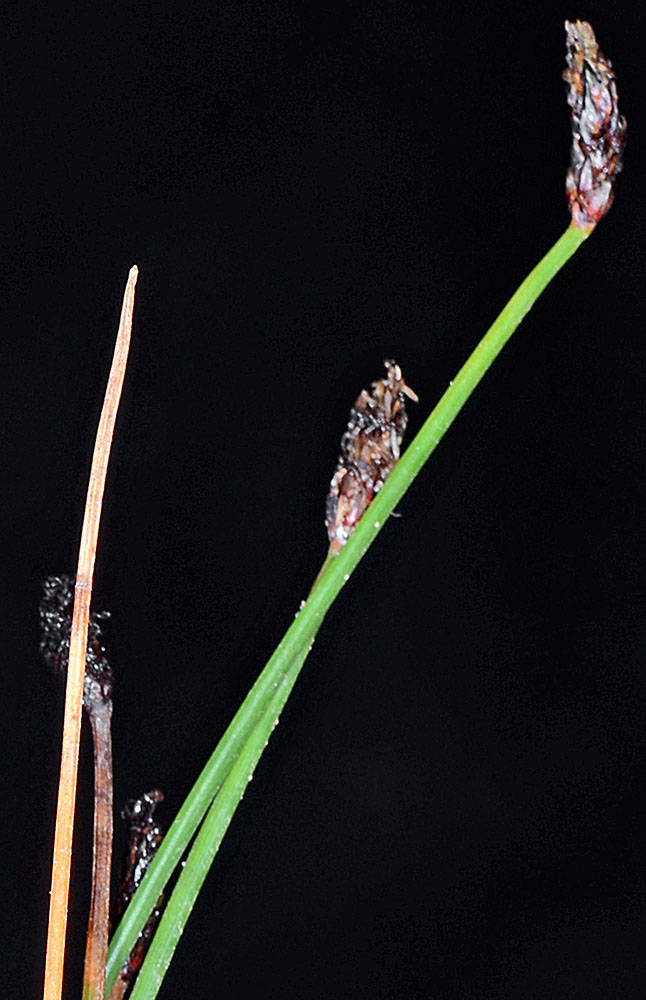Eleocharis engelmannii
Eleocharis macrostachya
Engelmann's spikerush
confusing spikerush, pale spikerush
terete, 2–40 cm × 0.5–1.5(2) mm.
terete to markedly compressed; to 3 times wider than thick, 10–100 cm × 0.5–2.5(3.5) mm.
lanceoloid to subcylindric, 5–10(20) × 2–3(4) mm;
proximal scale empty, encircling approximately 67% of culm; floral scales 25–100(200), 8–12 per mm of rachilla, 2(2.5) × 1–1.3 mm;
apex narrowly rounded to subacute.
narrowly lanceoloid to ovoid, 5–40 × 2–5 mm;
proximal scale clasping (6)75(100)% of culm usually variably in same plant, subproximal scale usually empty in some spikes and subtending a flower in other spikes in the same clone; floral scales 30–80, 3–5 per mm of rachilla, 2.5–5.5 × 1.5–2.5 mm.
perianth bristles present or often absent; (0)5–8; about as long as the achenes;
anthers 0.3–0.7(1) mm;
stigmas 2–3.
perianth bristles 4(5), sometimes rudimentary or absent; much shorter than achene to equaling tubercle;
stamens 2(3);
anthers 1.3–2.7 mm;
stigmas 2.
biconvex or to 33% greatly compressed trigonous, 0.9–1.1(1.5) × 0.7– 1.1 mm.
biconvex to plano-convex, 1.1–1.9 × 0.8–1.5 mm.
persistent, apex of distal leaf sheath obtuse to acute, with tooth to 0.3 mm.
persistent;
apex truncate to obtuse; tooth sometimes present on some or all culms, 0.1–0.6(1) mm.
depressed, subdeltoid, 0.1–0.3(0.4) × 0.6–0.9(1) mm, 10–40% as high as wide, 25% or less as high as achene, 90% as wide as achene.
pyramidal; as high as or sometimes much higher than wide, 0.35–0.7 × 0.25–0.7 mm.
=18, 19, 38.
Eleocharis engelmannii
Eleocharis macrostachya
Freshwater shores exposed by seasonal low water levels, marshes, disturbed wetlands. 50–500 m. WV. CA, ID, WA; north to British Columbia, east to MA, southeast to AL. Native.
Eleocharis engelmannii is similar to E. ovata and the much more common E. obtusa but has markedly shorter tubercles and usually more cylindric spikes.
Fresh to slightly brackish or alkaline marshes, lake shores, stream beds, vernal pools, deflation plains, and wet meadows. 0–1800 m. BR, BW, Col, CR, ECas, Est, Lava, Owy, Sisk, WV. CA, ID, NV, WA; north to AK, east to Quebec and MS, south to Mexico; South America. Native.
Eleocharis macrostachya is a diploid-polyploid complex consisting (at least in part) of populations that originated as hybrids of E. palustris with E. erythropoda and E. uniglumis. As a result, E. macrostachya is one of the most variable species in the genus. Plants vary from short, narrow-culmed plants resembling E. erythropoda to fairly robust individuals resembling E. palustris. The extent to which the proximal scale clasps the culm is usually greater than in E. palustris and often varies within a clone, as does the present or absence of a flower in the subproximal scale. Strictly coastal individuals have shiny dark chestnut brown or blackish achenes with brownish midribs. The proximal scales usually clasp 95–100% of the culm, and the subproximal scales usually subtend flowers. The culms are tough and sometimes arching. These plants can be referred to as E. macrostachya variant C (coastal form) or E. macrostachya tending toward E. uniglumis, according to Smith et al. (2002). Most inland Oregon plants are referred to as E. m. variant B.
Barbara Wilson, Richard Brainerd, Nick Otting
Barbara Wilson, Richard Brainerd, Nick Otting
- Local floras:
BC,
CA,
OR,
WA
- Local Web sites:
CalFlora,
CalPhotos,
Flora NW,
PNW Herbaria
WildflowerSearch
iNaturalist (observations)
USDA Plants Database
- LBJ Wildflower Center
- SEINet
- Plants of the World Online
- Encyclopedia of Life
- Wikipedia
- Google Image Search
- Local floras:
BC,
CA,
OR,
WA
- Local Web sites:
CalFlora,
CalPhotos,
Flora NW,
PNW Herbaria
WildflowerSearch
iNaturalist (observations)
USDA Plants Database
- LBJ Wildflower Center
- SEINet
- Plants of the World Online
- Encyclopedia of Life
- Wikipedia
- Google Image Search




